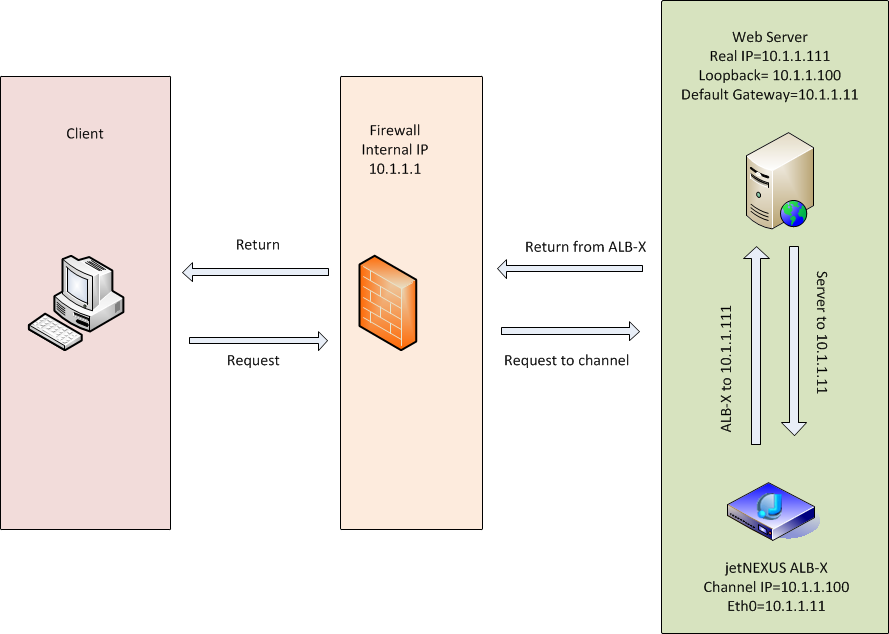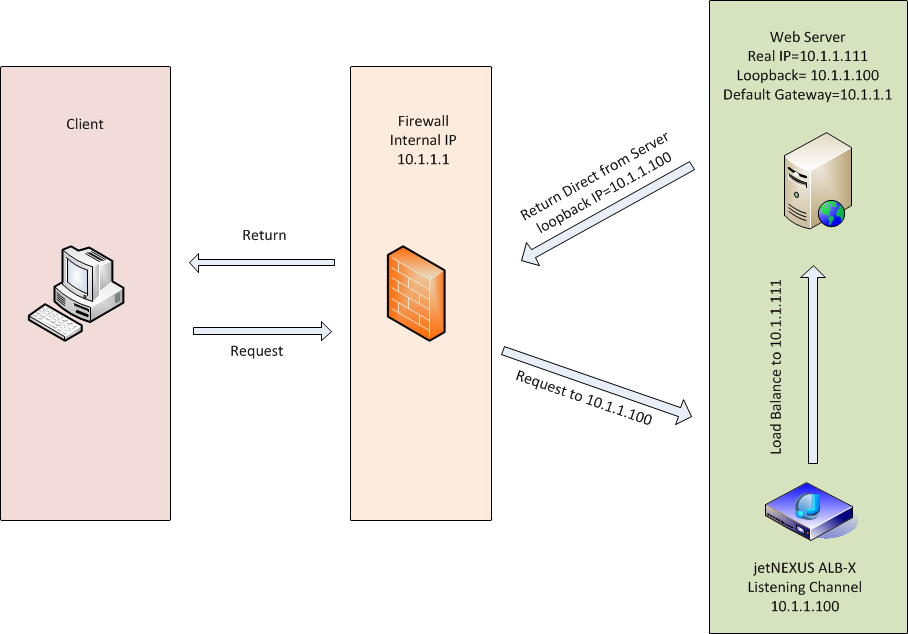Content Server Changes
This section is split in to the following sections:
Transparency
Transparency is suitable for Service Type Layer 4 load balancing only, Caching and Compression are not available when transparency is enabled. Transparency is used when you need the source address of the client making the request:
How it works
- Client sends a request to the edgeNEXUS
- Request is received by edgeNEXUS
- MAC address is changed. Request forwarded to content servers
- Response sent to edgeNEXUS
- edgeNEXUS routes the response to the client
Transparency Diagram

Required Content Server Configuration
General
- Content servers need to be configured to use the edgeNEXUS Eth0 IP address as their default gateway for single arm configuration
- Content server need to be configured to use the edgeNEXUS Eth1 IP address as their default gateway for dual arm configuration
- The content server and the load balancer must be in the same subnet
Windows
- The content server needs to have a loopback or Alias configure with the IP address of the Channel or VIP
- Network metric must be 254 to prevent response to ARP requests
- Modify the netmask to be 255.255.255.255
- Add a loopback adapter in Windows Server 2012 – Click here
- Add a loopback adapter in Windows Server 2003/2008 – Click here
- Run the following in a command prompt
- netsh interface ipv4 set interface “net” weakhostreceive=enabled
- netsh interface ipv4 set interface “loopback” weakhostreceive=enabled
- netsh interface ipv4 set interface “loopback” weakhostsend=enabled
- To Disable – should you wish to back out of the configuration
- netsh interface ipv4 set interface “net” weakhostreceive=disabled
- netsh interface ipv4 set interface “loopback” weakhostreceive=disabled
- netsh interface ipv4 set interface “loopback” weakhostsend=disabled
The network metric is set in the Advanced TCP/IP Settings of the loopback Interface

Linux
- 1. Add a permanent loopback interface
- 2. Edit “/etc/sysconfig/network-scripts”
- ifcfg-lo:1
DEVICE=lo:1
IPADDR=x.x.x.x
NETMASK=255.255.255.255
BROADCAST=x.x.x.x
ONBOOT=yes
- ifcfg-lo:1
- 3. Edit “/etc/sysctl.conf”
- net.ipv4.conf.all.arp_ignore = 1
net.ipv4.conf.eth0.arp_ignore = 1
net.ipv4.conf.eht1.arp_ignore = 1
net.ipv4.conf.all.arp_announce = 2
net.ipv4.conf.eth0.arp_announce = 2
net.ipv4.conf.eth1.arp_announce = 2
- net.ipv4.conf.all.arp_ignore = 1
- 4. Run “sysctl – p”
Direct Server Return
Direct Server Return, or DSR as it’s widely known (DR – Direct Routing in some circles) allows the server behind the load balancer to respond directly to the client bypassing the edgeNEXUS on the response. DSR is suitable for using with Layer 4 load balancing only therefore Caching and Compression are not available when enabled.
Layer 7 load balancing with this method will not work therefore there is no persistence support other than source IP. SSL/TLS load balancing with this method is not ideal as there is only source IP persistence support.
How it Works
- Client sends a request to the edgeNEXUS
- Request received by edgeNEXUS
- Request routed to content servers
- Response sent directly to client without passing through JetNEXUS
DSR Diagram

Required Content Server Configuration
General
- The content server default gateway should be configured as normal. (Not via the jetNEXUS)
- The content server and the load balancer must be in the same subnet
Windows
- The content server needs to have a loopback or Alias configure with the IP address of the Channel or VIP
- Network metric must be 254 to prevent response to ARP requests
- Add a loopback adapter in Windows Server 2012 – Click here
- Add a loopback adapter in Windows Server 2003/2008 – Click here
- Run the following in a command prompt
- netsh interface ipv4 set interface “net” weakhostreceive=enable
- netsh interface ipv4 set interface “loopback” weakhostreceive=enable
- netsh interface ipv4 set interface “loopback” weakhostsend=enable
Linux
- 1. Add a permanent loopback interface
- 2. Edit “/etc/sysconfig/network-scripts”
- ifcfg-lo:1
DEVICE=lo:1
IPADDR=x.x.x.x
NETMASK=255.255.255.255
BROADCAST=x.x.x.x
ONBOOT=yes
- ifcfg-lo:1
- 3. Edit “/etc/sysctl.conf”
- net.ipv4.conf.all.arp_ignore = 1
net.ipv4.conf.eth0.arp_ignore = 1
net.ipv4.conf.eht1.arp_ignore = 1
net.ipv4.conf.all.arp_announce = 2
net.ipv4.conf.eth0.arp_announce = 2
net.ipv4.conf.eth1.arp_announce = 2
- net.ipv4.conf.all.arp_ignore = 1
- 4. Run “sysctl – p”
Gateway
Gateway mode allows you to route all traffic through the jetNEXUS, this allows traffic originating from the content servers to be routed via the edgeNEXUS to other networks via the interfaces on the edgeNEXUS unit. Using the device as a gateway device for content servers should be used when running in multi interface mode
How it works
- Client sends a request to the edgeNEXUS
- Request is received by edgeNEXUS
- Request sent to content servers
- Response sent to edgeNEXUS
- edgeNEXUS routes the response to the client
Required Content Server Configuration
- Content servers need to be configured to use the edgeNEXUS Eth0 IP address as their default gateway
- Content servers need to be configured to use the edgeNEXUS Eth1 IP address as their default gateway for dual arm configuration
- The content server and the load balancer must be in the same subnet
Windows
On windows the following commands must be run at the command prompt running in administrator mode. Where net is the name of the name of the interface:
- The content server needs to have a loopback or Alias configure with the IP address of the Channel or VIP
- Network metric must be 254 to prevent response to ARP requests
- Modify the netmask to be 255.255.255.255
- Add a loopback adapter in Windows Server 2012 – Click here
- Add a loopback adapter in Windows Server 2003/2008 – Click here
- Run the following in a command prompt
- netsh interface ipv4 set interface “net” weakhostreceive=enable
- netsh interface ipv4 set interface “loopback” weakhostreceive=enable
- netsh interface ipv4 set interface “loopback” weakhostsend=enable
Linux
- 1. Add a permanent loopback interface
- 2. Edit “/etc/sysconfig/network-scripts”
- ifcfg-lo:1
DEVICE=lo:1
IPADDR=x.x.x.x
NETMASK=255.255.255.255
BROADCAST=x.x.x.x
ONBOOT=yes
- ifcfg-lo:1
- 3. Edit “/etc/sysctl.conf”
- net.ipv4.conf.all.arp_ignore = 1
net.ipv4.conf.eth0.arp_ignore = 1
net.ipv4.conf.eht1.arp_ignore = 1
net.ipv4.conf.all.arp_announce = 2
net.ipv4.conf.eth0.arp_announce = 2
net.ipv4.conf.eth1.arp_announce = 2
- net.ipv4.conf.all.arp_ignore = 1
- 4. Run “sysctl – p”